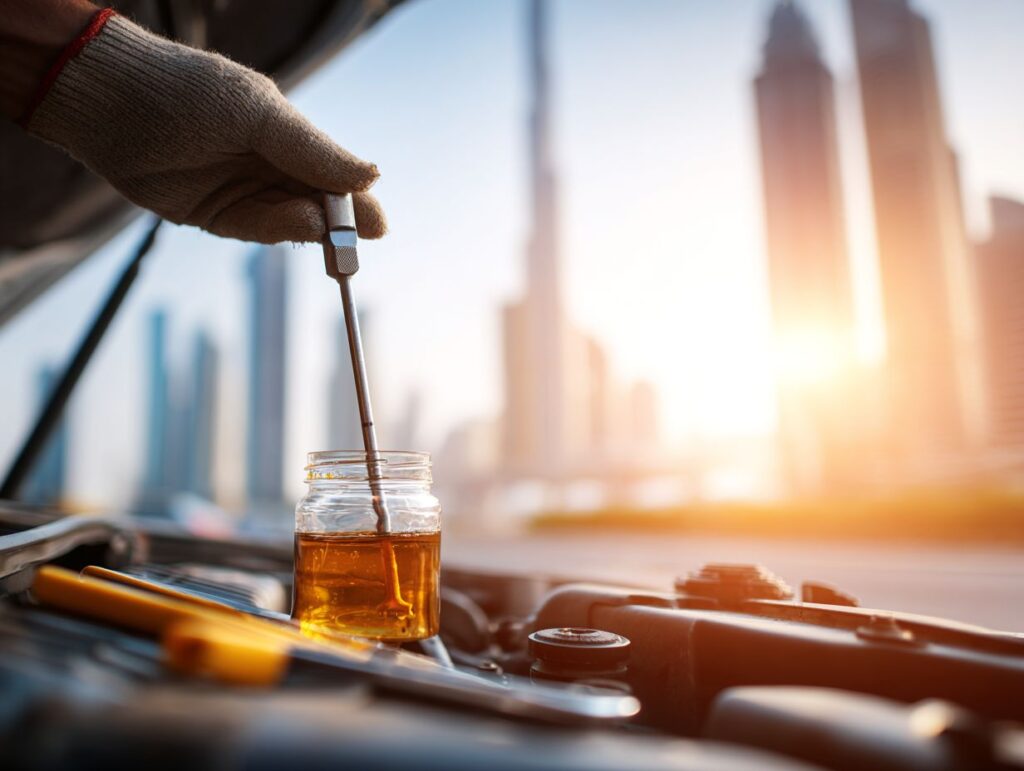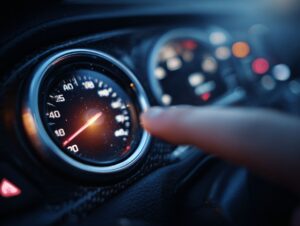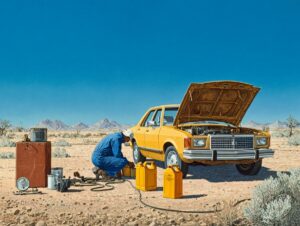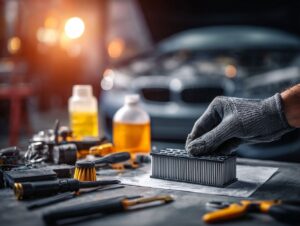In the intense UAE heat, taking care of your luxury car’s brakes is important for safety and function. Knowing how to check your brake fluid levels can prevent costly repairs for brands like BMW, Audi, and Mercedes.
This guide will walk you through the simple steps to inspect brake fluid, explain color meanings, and highlight the effects of high temperatures on fluid integrity. Find out how 55CarGarage’s certified technicians can keep your car’s fluids-brake, engine oil, and transmission-in perfect condition.
Key Takeaways:
- Check the brake fluid often to keep driving safely. Locate reservoir and inspect fluid level and color for proper maintenance.
- Knowing what different brake fluid colors mean is important. Dark or milky appearance indicates potential issues and requires immediate action.
- High temperatures in UAE can cause brake fluid to degrade quickly. Regular inspections and replacements by professionals at 55CarGarage are recommended.
Steps to Check Brake Fluid Level
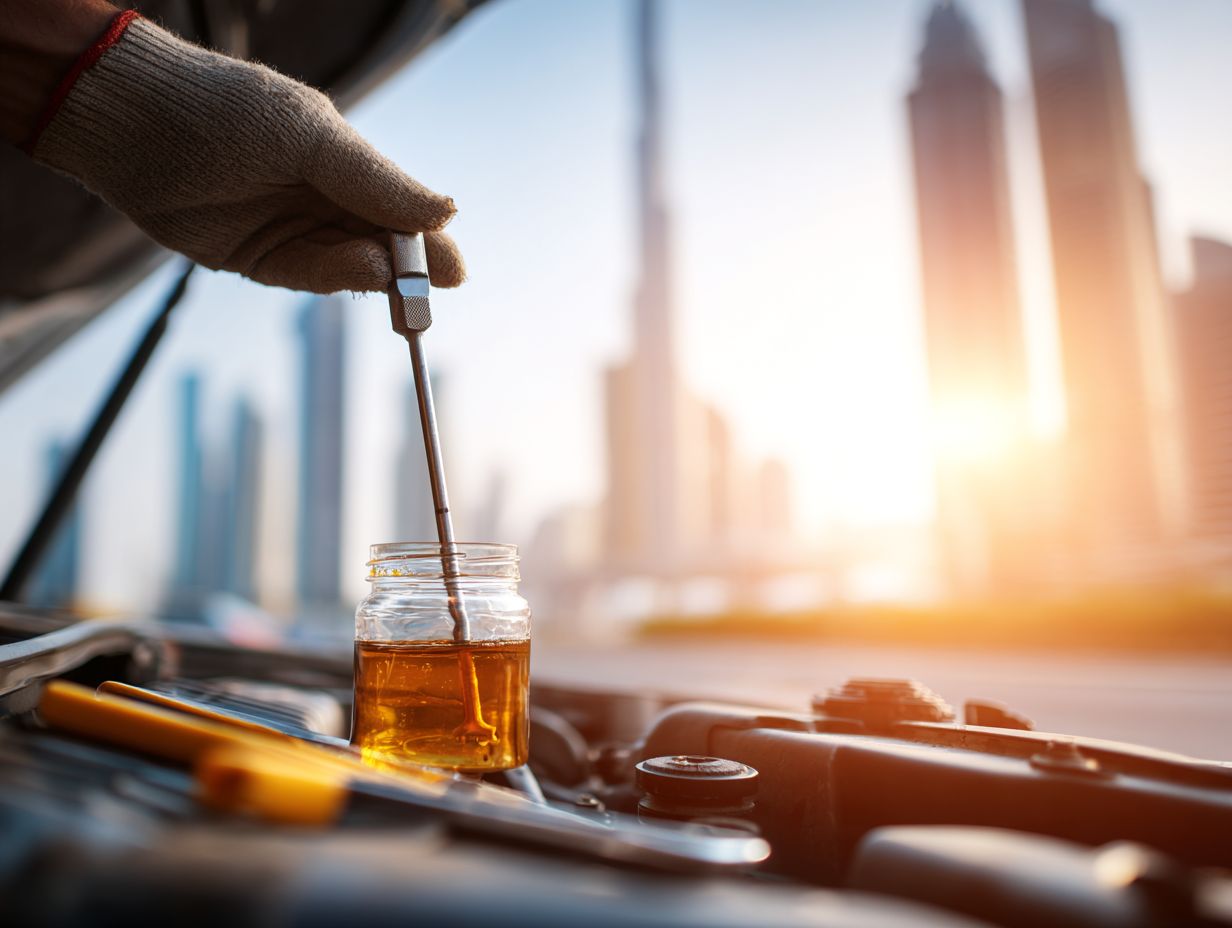
Checking that your brake fluid is at the right level is important for your car’s performance and safety, especially in the UAE’s hot climate where the fluid can break down more quickly.
1. Locate the Brake Fluid Reservoir
The brake fluid reservoir is typically a small, translucent container located within the engine compartment, often near the back, easily identifiable by a cap marked with a brake symbol.
To check the brake fluid level, first make sure the engine is not hot. Open the cap carefully to avoid spills, and check the fluid level against the markings on the reservoir.
If the level is low, top it off using the recommended brake fluid for your vehicle, which is typically either DOT 3 or DOT 4. Do not mix fluids from different manufacturers.
After refilling, securely close the cap and start the engine to verify that the brake warning light on the dashboard is off, indicating normal function.
2. Inspect Fluid Level Markings
Inspecting the fluid levels involves comparing the current fluid level against clearly marked ‘MIN’ and ‘MAX’ indicators on the reservoir.
Before you start, make sure your car is parked on flat ground and has been off for a few minutes. This allows the fluid to settle.
Using a flashlight, inspect the reservoir carefully; if the level is below ‘MIN’, add the appropriate brake fluid type specified in your owner’s manual, such as DOT 3 or DOT 4. For topping up, use a clean funnel to avoid contamination. Check your brakes every month to avoid problems and drive safely.
3. Assess Fluid Color and Clarity
The color and clarity of brake fluid can show its condition; clear fluid means it’s in good shape, while dark or cloudy fluid indicates it may be contaminated.
To keep your brakes working well, inspect them twice a year. If you notice a change in fluid color, perform a visual check for leaks or moisture around brake components.
Tools like a brake fluid tester can help assess moisture content-aim for less than 3% moisture for safe driving. If the fluid is dark, it’s best to consult a mechanic for a complete flush and replacement. Regular maintenance avoids costly repairs and keeps your brakes reliable.
What Brake Fluid Colors Mean
Knowing what different brake fluid colors mean is important for keeping your vehicle safe and running well, particularly in the tough conditions of the UAE.
1. Clear vs. Dark Fluid
Clear brake fluid typically indicates good condition, while dark fluid suggests degradation and potential moisture absorption, which can lead to brake issues.
Dark brake fluid generally indicates that it has absorbed moisture and contaminants, compromising its effectiveness. You should schedule a professional inspection if you notice this change.
Brake fluid typically lasts around two years. During routine check-ups, think about changing it to keep your brakes working well. Watch other indicators: if you feel a spongy brake pedal or notice decreased responsiveness, these could also signify brake fluid issues. Regularly checking your fluid can prevent more extensive brake problems down the line.
2. Milky or Cloudy Appearance
If brake fluid looks milky or cloudy, it often means there is moisture in it, which can seriously affect how well the brakes work.
To address this issue effectively, first, replace the contaminated fluid with high-quality DOT fluid. Properly bleed the brake lines to remove air, which can lower braking effectiveness. Next, inspect the brake system for potential leaks or wear, focusing on the seals and hoses.
Tools like a brake fluid tester can help you gauge moisture levels before and after replacement. Consider booking an appointment with a trusted mechanic to assess any underlying issues that may have led to this contamination, ensuring your vehicle’s safety.
Effects of UAE Heat on Brake Fluid
In the UAE, the intense heat can greatly affect how long brake fluid lasts and how well it works, causing it to break down faster and possibly lead to brake failures. For an extensive analysis of this trend, our comprehensive study on vehicle challenges during Dubai’s summer heat offers useful insights into maintaining car performance in extreme temperatures.
Fluid Degradation in High Temperatures
Brake fluid can degrade rapidly in high temperatures, leading to reduced performance and increased risk of brake failure. To keep your car safe, check your brake fluid often in the summer. If it appears dark or cloudy, replace it using a flush kit – you can find affordable options at automotive stores.
Schedule professional maintenance at least twice a year, especially before long trips or extreme weather. During extreme heat events, consider a mid-season inspection to mitigate risks.
Use a moisture test strip to measure fluid quality; if it exceeds the recommended level of moisture content, immediate replacement is advisable.
Professional Brake Inspection Services in Dubai
Certified technicians at service centers like 55CarGarage can help keep your brake system in top condition, especially in a place like Dubai. If you’re interested in knowing more about the comprehensive car repair services available in Dubai, their expert solutions cover everything from routine maintenance to complex repairs.
55CarGarage Certified Technicians
At 55CarGarage, qualified technicians carry out detailed checks on brake systems to keep drivers safe and secure on Dubai’s roads.
These inspections encompass a detailed assessment of brake pads, rotors, and fluid levels. For instance, technicians often identify wear patterns that indicate the need for replacement, addressing issues before they escalate.
55CarGarage offers complimentary brake checks and fluid replacement packages, which encourage proactive vehicle maintenance. By setting up a visit, drivers can improve their safety and extend the life of their brakes, while getting expert advice customized for Dubai’s unique driving conditions.
Frequently Asked Questions
1. What is the proper way to check brake fluid level in my car in Dubai?
To check the brake fluid level in your car, first make sure the car is parked on a level surface and the engine is off. Then, locate the brake fluid reservoir, typically located on the driver’s side of the engine bay. The fluid level should be between the “min” and “max” markers on the reservoir. If it is below the “min” marker, it’s time to top off the brake fluid.
2. What do the different colors of brake fluid mean and what should I look for?
Brake fluid can come in different colors, but the most common are clear, amber, and dark brown. Clear or light amber brake fluid indicates that the fluid is still in good condition. Dark brown fluid may indicate that the fluid needs to be changed. If the fluid is black, it is a sign of contamination and should be checked by a professional.
3. How does the heat in Dubai affect my car’s brake fluid?
The extreme heat in Dubai can cause the brake fluid to break down faster, resulting in a decrease in its effectiveness. It can also result in air bubbles forming in the brake lines, which may make the brake pedal feel soft and reduce how well the brakes work. Check and replace the brake fluid often to make sure your brakes work well in hot weather.
4. Why should I have my brake fluid checked and replaced by a professional?
It is recommended to have your brake fluid checked and replaced by a certified technician, especially in Dubai where the heat can affect the fluid’s performance. 55CarGarage provides expert services for checking brakes and changing brake fluid. Our certified technicians know the needs of UAE vehicles and maintain brake systems correctly.
5. How often should I check my car’s brake fluid level in Dubai?
Check your car’s brake fluid level every 6 months or after driving 10,000 kilometers, whichever happens first. If you observe any changes in how your car brakes or if the brake fluid looks dark, have it examined by a professional right away.
6. What happens if I neglect to check and replace my car’s brake fluid in Dubai?
If you don’t regularly check and change your car’s brake fluid, your brakes may not work as well, which can be risky when driving in Dubai. It can also cause damage to your car’s brake system, resulting in costly repairs. Regularly checking and maintaining your car’s brake fluid is essential for safe driving in Dubai’s hot weather.

